-
Paper Information
- Next Paper
- Paper Submission
-
Journal Information
- About This Journal
- Editorial Board
- Current Issue
- Archive
- Author Guidelines
- Contact Us
American Journal of Operational Research
p-ISSN: 2324-6537 e-ISSN: 2324-6545
2013; 3(A): 1-6
doi:10.5923/s.ajor.201305.01
M/M/1 Feedback Queueing Models with Retention of Reneged Customers and Balking
Rakesh Kumar, Sumeet Kumar Sharma
School of Mathematics, Shri Mata Vaishno Devi University, Katra, Sub Post- Office, University Campus, Postcode 182320, Jammu and Kashmir, India
Correspondence to: Rakesh Kumar, School of Mathematics, Shri Mata Vaishno Devi University, Katra, Sub Post- Office, University Campus, Postcode 182320, Jammu and Kashmir, India.
| Email: |  |
Copyright © 2012 Scientific & Academic Publishing. All Rights Reserved.
Customer retention is the key issue in the organizations facing the problem of customer impatience. Firms are employing a number of customer retention strategies to sustain their businesses. An impatient customer (due to reneging) may be convinced to stay in service system for his service by utilizing certain convincing mechanisms. Such customers are termed as retained customers. Queuing with feedback represents customer dissatisfaction because of inappropriate quality of service. In case of feedback, after getting partial or incomplete service, customer retries for service. Customer Retention is incorporated in a single-server Markovian feedback queuing model and in a single-server Markovian feedback queuing model with balking. The steady-state solution of both the models is derived. Some useful measures of performance are derived. Some queuing models are obtained as particular cases of these models are discussed.
Keywords: Customer retention, Feedback, Reneging; Balking, Steady-state Solution
Cite this paper: Rakesh Kumar, Sumeet Kumar Sharma, M/M/1 Feedback Queueing Models with Retention of Reneged Customers and Balking, American Journal of Operational Research, Vol. 3 No. A, 2013, pp. 1-6. doi: 10.5923/s.ajor.201305.01.
Article Outline
1. Introduction
- Queuing with customer impatience has special significance for the business world as it has a very negative effect on the revenue generation of a firm. Customer impatience leads to loss of potential customers. It has become a highly challenging problem in the current era of cut-throat competition. Customers are the backbone of any business, because without customers there will be no reason for a business to operate. Therefore, the concept of customer retention assumes a tremendous importance for the business management. Customer retention is the key issue in the organizations facing the problem of customer impatience. Firms are employing a number of customer retention strategies to sustain their businesses. An impatient customer (due to reneging) may be convinced to stay in service system for his service by utilizing certain convincing mechanisms. Such customers are termed as retained customers. An impatient customer (due to reneging) may be convinced to stay in service system for his service by utilizing certain convincing mechanisms. Such customers are termed as retained customers. When a customer gets impatient, he may leave the queue with some probability, say
 and may remain in the queue for service with some complementary probability
and may remain in the queue for service with some complementary probability  .Recently, Kumar and Sharma[10] study the retention of reneged customers in an M/M/1/N queuing model and perform sensitivity analysis of the model. Balking is a common phenomenon of not joining a queue because the prospective arriving customer estimates the queue to be too long. The concept of balking finds its applications not only in daily life, but in computer communication, production systems and hospital management.Kumar and Sharma[11] study M/M/1/N queuing system with retention of reneged customers and balking. They extend the work of Kumar and Sharma[10] by taking balking aspects in their model to study the effect of probability of retaining the reneged customers on expected system size. They perform the sensitivity analysis of the model.The balking assumption in infinite case modified in the present paper as an arriving customer whenever he finds the server is busy on arrival, he may balk with certain balking probability. He may balk with probability
.Recently, Kumar and Sharma[10] study the retention of reneged customers in an M/M/1/N queuing model and perform sensitivity analysis of the model. Balking is a common phenomenon of not joining a queue because the prospective arriving customer estimates the queue to be too long. The concept of balking finds its applications not only in daily life, but in computer communication, production systems and hospital management.Kumar and Sharma[11] study M/M/1/N queuing system with retention of reneged customers and balking. They extend the work of Kumar and Sharma[10] by taking balking aspects in their model to study the effect of probability of retaining the reneged customers on expected system size. They perform the sensitivity analysis of the model.The balking assumption in infinite case modified in the present paper as an arriving customer whenever he finds the server is busy on arrival, he may balk with certain balking probability. He may balk with probability  or he may join the system with probability
or he may join the system with probability  such that
such that  .In computer communication, the transmission of protocol data unit is sometimes repeated due to occurrence of an error. This usually happens because of non-satisfactory quality of service. Rework in industrial operations is also an example of queues with feedback. We assume that after the completion of service, each customer may rejoin the system as a feedback customer for receiving another regular service with probability p1 and may not join with complementary probability 1- p1.Sharma and Kumar[17] study single-server finite capacity, Markovian queue with feedback and retention of reneged customers. They perform steady-state analysis of the model. Sharma and Kumar[18] further study M/M/1/N feedback queuing model with balking and retention of reneged customers in the same year. They obtain steady-state solution of the model. They derive important performance measures of the model. Some queuing models are derived as special cases of the model. In this paper, we extend the work of Sharma and Kumar[17] by taking infinite capacity case of the model. Some useful measures of performances are derived. Some queuing models are obtained as particular cases of the model. Balking in infinite case of the model is also considered in the present paper.The paper is arranged as follows: In section 2, literature survey is presented. Section 3 deals with steady-state analysis of a single-server Markovian feedback queuing system with retention of reneged customers. In section 4, M/M/1 queuing model with retention of reneged customers and balking is considered. The steady-state solution, measures of performances and some particular cases of the model are obtained. The paper is concluded in section 5.
.In computer communication, the transmission of protocol data unit is sometimes repeated due to occurrence of an error. This usually happens because of non-satisfactory quality of service. Rework in industrial operations is also an example of queues with feedback. We assume that after the completion of service, each customer may rejoin the system as a feedback customer for receiving another regular service with probability p1 and may not join with complementary probability 1- p1.Sharma and Kumar[17] study single-server finite capacity, Markovian queue with feedback and retention of reneged customers. They perform steady-state analysis of the model. Sharma and Kumar[18] further study M/M/1/N feedback queuing model with balking and retention of reneged customers in the same year. They obtain steady-state solution of the model. They derive important performance measures of the model. Some queuing models are derived as special cases of the model. In this paper, we extend the work of Sharma and Kumar[17] by taking infinite capacity case of the model. Some useful measures of performances are derived. Some queuing models are obtained as particular cases of the model. Balking in infinite case of the model is also considered in the present paper.The paper is arranged as follows: In section 2, literature survey is presented. Section 3 deals with steady-state analysis of a single-server Markovian feedback queuing system with retention of reneged customers. In section 4, M/M/1 queuing model with retention of reneged customers and balking is considered. The steady-state solution, measures of performances and some particular cases of the model are obtained. The paper is concluded in section 5.2. Literature Survey
- The concept of customer impatience appears in queuing theory in the work of Haight[7]. Haight[8] studies queuing with reneging. Ancker and Gafarian[1] study M/M/1/N queuing system with balking and reneging and derive its steady-state solution. Ancker and Gafarian[2] obtain results for a pure balking system (no reneging) by setting the reneging parameter equal to zero. Al-seedy et al.[4] study M/M/c queue with balking and reneging and derived its transient solution by using the probability generating function technique and the properties of Bessel function.Choudhury and Medhi[6] study customer impatience in multi-server queues. They consider both balking and reneging as functions of system state by taking into consideration the situations where the customer is aware of its position in the system. Kapodistria[9] study a single server Markovian queue with impatient customers and consider the situations where customers abandon the system simultaneously. He consider two abandonment scenarios. In the first one, all present customers become impatient and performed synchronized abandonments, while in the second scenario; the customer in service is excluded from the abandonment procedure. He extends this analysis to the M/M/c queue under the second abandonment scenario also. The earlier work on feedback is found in Takacs[20]. He studies queue with feedback to determine the stationary process for the queue size and the first two moments of the distribution function of the total time spent in the system by a customer. Davignon and Disney[5] study single server queues with state dependent feedback. Santhakumaran and Thangaraj[16] consider a single server feedback queue with impatient and feedback customers. They study M/M/1 queueing model for queue length at arrival epochs and obtain result for stationary distribution, mean and variance of queue length. Thangaraj and Vanitha[21] obtain transient solution of M/M/1 feedback queue with catastrophes using continued fractions. The steady-state solution, moments under steady state and busy period analysis are calculated. Ayyappan et al.[3] study M/M/1 retrial queueing system with loss and feedback under non-pre-emptive priority service by matrix geometric method.Customer retention in a single-server, finite capacity, Markovian queuing model is firstly studied by Kumar and Sharma[10]. The related work on customer retention and its application is in[12-15]. In this paper, infinite capacity, single-server Markovian feedback queuing model with customer retention is studied. The steady-state analysis is performed. The above model is extended by taking into account the aspects of balking. The steady state probabilities are obtained iteratively in case of reneging, balking and retention of reneged customers. The performance measures are derived and some queuing models are discussed as particular cases of the model.
3. M/M/1 Feedback Queuing Model with Retention of Reneged Customers
- We consider an M/M/1 feedback queuing model with reneging. In case of feedback, after the completion of service, each customer may rejoin the system as a feedback customer for receiving another regular service with probability p1 and may not join with complementary probability 1- p1.The reneging times are assumed to exponentially distributed with parameter
 . It is envisaged that a reneged customer may be convinced by applying certain convincing mechanism to stay in the system for his service. Thus, there is a probability say,
. It is envisaged that a reneged customer may be convinced by applying certain convincing mechanism to stay in the system for his service. Thus, there is a probability say,  that a reneged customer may be retained in the system and may not be retained with some complementary probability say,
that a reneged customer may be retained in the system and may not be retained with some complementary probability say,  The differential-difference equations of the model are:
The differential-difference equations of the model are:  | (1) |
 | (2) |
 and therefore,
and therefore,  and hence, the equations (1) and (2) give the difference equations
and hence, the equations (1) and (2) give the difference equations | … (3) |
 | … (4) |
 | … (5) |
 | … (6) |

3.1. Measures of Performance
- In this section, some important measures of performance are derived. These can be used to study the performance of the queuing system under consideration.
3.1.1. The Expected System Size, 


3.1.2. The Expected Queue Length (Lq)


3.1.3. The Expected Waiting Time in the System (Ws)
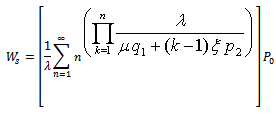
3.1.4. The Expected Waiting Time in the queue (Wq)

3.1.5. The Expected Number of customers Served, 
- The expected number of customers served is given by
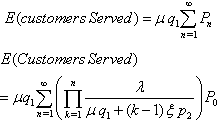
3.1.6. Rate of Abandonment, 


3.1.7. Expected number of waiting customers, who actually wait, 
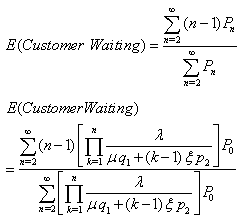 where
where  is derived in (6).
is derived in (6).3.2. Particular Cases of the Model
- In this section, we derive some important Markovian queuing models from the M/M/1 feedback queuing model with retention of reneged customers.
3.2.1. When the Probability of Retention of Reneged Customer (i.e. for q2=0)
- In the absence of retention of reneged customer (i.e. for q2=0), our model reduces to an M/M/1 feedback queuing model with reneging with
 and
and
3.2.2. When the Capacity of the System is Finite
- When the capacity of the system is taken as finite say, N, the resulting model is an M/M/1/N feedback queuing model with retention of reneged customers as studied by Kumar and Sharma[17] with
 and
and  4. M/M/1 Feedback Queuing Model with Retention of Reneged Customers and BalkingThe model in section 3 is extended by taking into account the balking aspects of the model. We assume that an arriving customer whenever he finds the server is busy on arrival, he may balk with certain balking probability. He may balk with probability
4. M/M/1 Feedback Queuing Model with Retention of Reneged Customers and BalkingThe model in section 3 is extended by taking into account the balking aspects of the model. We assume that an arriving customer whenever he finds the server is busy on arrival, he may balk with certain balking probability. He may balk with probability  or he may join the system with probability
or he may join the system with probability  such that
such that  . The other assumptions of the model remain the same as described in section 3. The differential-difference equations of the model are:
. The other assumptions of the model remain the same as described in section 3. The differential-difference equations of the model are:  | … (7) |
 | … (8) |
 | (9) |
 and therefore,
and therefore,  and hence, the equations (7), (8), and (9) become
and hence, the equations (7), (8), and (9) become | … (10) |
 | … (11) |
 | … (12) |
 | … (13) |
 | (14) |

4.1. Measures of Performance
4.1.1. The Expected System Size, 


4.1.2. The Expected Queue Length (Lq)


4.1.3. The Expected Waiting Time in the System (Ws)

4.1.4. The Expected Waiting Time in the queue (Wq)

4.1.5. The Expected Number of customers Served, 
- The expected number of customers served is given by


4.1.6. Rate of Abandonment, 


4.1.7. Expected number of waiting Customers, who Actually Wait, 

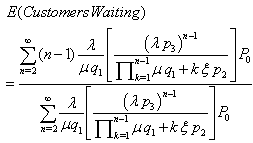 where
where  is derived in (14).
is derived in (14).4.2. Particular Cases of the Model
- In this section, we derive some important Markovian queuing models from the M/M/1 feedback queuing model with retention of reneged customers and balking.
4.2.1. When the Probability of Retention of Reneged Customer (i.e. for q2=0)
- In the absence of retention of reneged customer (i.e. for q2=0), our model reduces to an M/M/1 feedback queuing model with reneging and balking with
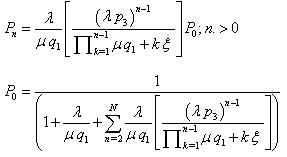
4.2.2. When the Capacity of the System Is Finite Say, N
- The resulting model is an M/M/1/N feedback queuing model with retention of reneged customers and balking with

 In the absence of balking, when
In the absence of balking, when  , the model reduces to M/M/1 feedback queuing model with retention of reneged customers as studied in section 2.
, the model reduces to M/M/1 feedback queuing model with retention of reneged customers as studied in section 2.5. Conclusions
- In this paper, we have studied customer retention in an M/M/1 feedback queuing model with reneging and in an M/M/1 feedback queuing model with reneging and balking.The steady-state solution is obtained for both the queuing models. Some important measures of performance are derived. Some important queuing models are obtained as particular cases of the model.
 Abstract
Abstract Reference
Reference Full-Text PDF
Full-Text PDF Full-text HTML
Full-text HTML